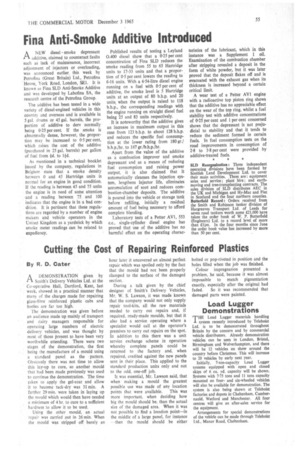Cutting the Cost of Repairing Reinforced Plastics
Page 57

If you've noticed an error in this article please click here to report it so we can fix it.
By R. D. Cater
A DEMONSTRATION given by I-1 Smith's Delivery Vehicles Ltd. at the Co-operative Hall, Dartford,. Kent, last week, showed in a practical manner that many of the charges made for repairing glass-fibre reinforced plastic cabs and bodies are far too high.
The demonstration was given before an audience made up mainly of transport and dairy managers responsible for operating large numbers of electric delivery vehicles, and was thought by most of those iiresent to have been very worthwhile attending. There were two stages of the demonstration, the first being the manufacture of a mould using a standard panel as the pattern. Obviously there was not time to allow this lay-up to cure, so another mould that had been made previously was used to continue the demonstration. The time taken to apply the gel-coat and allow it to become tack-dry was 31 min. A further 29 min. were taken in laying up the mould which would then have needed a minimum of 4 hr. to cure to a sufficient hardness to allow it to be used.
Using the other mould, an actual repair was carried out in 26 min. When the mould was stripped off barely an hour later it uncovered an almost perfect repair which was spoiled only by the fact that the mould had not been properly clamped to the surface of the damaged section.
During a talk given by the chief designer of Smith's Delivery Vehicles, Mr. W. S. Lawson, it was made known that the company would not only supply repair tool-kits, all the raw materials needed to carry out repairs and, if required, ready-made moulds, but that it also had a service operating where a specialist would call at the operator's premises to carry out repairs on the spot. In addition to this there was a unit service exchange scheme in operation whereby complete panels could be returned to the factory and, when repaired, credited against the new panels sent in their place. This applied to the standard production units only and not to the odd, one-off job.
It was essential, Mr. Lawson said, that when making a mould• the greatest possible use was made of any location
points that were available. This was more important, when deciding how big the mould should be, than the actual size of the damaged area. When it was not possible to find a location point—in the middle of a large panel, for instance --then the mould should be either bolted or pop-riveted in position and the holes filled when the job was finished.
Colour impregnation presented a problem, he said, because it was almost impossible to match pigmentation exactly, especially after the original had faded. So it was recommended that damaged parts were painted.
Load Lugger Demonstrations
THE Load Lugger materials handling
system recently introduced by Telehoist Ltd. is to be demonstrated throughout Britain by the concern and by commercial vehicle distributors. Already demonstration vehicles can be seen in London, Bristol, Birmingham and Wolverhampton, and there will be 12 vehicles on show around the country before Christmas. This will increase to 20 vehicles by early next year.
Initially, 7-ton-capacity Load Lugger systems equipped with open and closed skips of 6 cu. yd. capacity will be shown. Systems with 7.75 tons and 11 tons capacity mounted on fourand six-wheeled vehicleS will also be available for demonstration. The system is also being shown at Teiehoist factories and depots in Cheltenham, Cumbernauld, Watford and Manchester. All four centres will give an after-sales service for the equipment.
Arrangements for special demonstrations of the vehicle can be made through Telehoist Ltd., Manor Road, Cheltenham.
















































































































































































